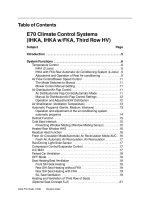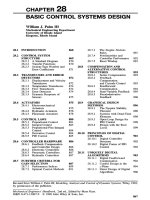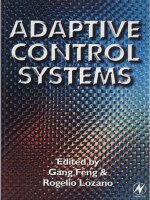Emission Control Systems
Bạn đang xem bản rút gọn của tài liệu. Xem và tải ngay bản đầy đủ của tài liệu tại đây (8.28 MB, 110 trang )
by
Russell Krick
Publisher
The Goodheart-Willcox Co., Inc.
Tinley Park, Illinois
© Goodheart-Willcox Co., Inc.
Permission granted to reproduce for educational use only
© Goodheart-Willcox Co., Inc.
Permission granted to reproduce for educational use only
(13 Topics)
Air pollution
Exhaust emissions
Engine modifications
Emission control systems
Positive crankcase ventilation (PCV)
Evaporative emissions control systems
Exhaust gas recirculation (EGR)
© Goodheart-Willcox Co., Inc.
Permission granted to reproduce for educational use only
Air injection system
Pulse air system
Thermostatic air cleaner system
Catalytic converter
Computerized emission control
systems
OBD II emission system monitoring
© Goodheart-Willcox Co., Inc.
Permission granted to reproduce for educational use only
Caused by an excess amount of
harmful chemicals in the atmosphere
Emission control systems are used on
cars and trucks to reduce harmful
chemicals in the atmosphere
© Goodheart-Willcox Co., Inc.
Permission granted to reproduce for educational use only
Air Pollution
There are many sources, both
natural and man-made
© Goodheart-Willcox Co., Inc.
Permission granted to reproduce for educational use only
Natural Sources
Volcanoes
Forest fires
Dust
Decay of vegetation
© Goodheart-Willcox Co., Inc.
Permission granted to reproduce for educational use only
Man-Made Sources
Factories
Home furnaces
Fireplaces
Internal combustion engines
© Goodheart-Willcox Co., Inc.
Permission granted to reproduce for educational use only
Smog
Visible cloud of airborne pollutants
Derived from the words “smoke” and
“fog”
Harmful to humans, animals, and
vegetation
Formed when pollutants combine with
oxygen and nitrogen in the presence of
sunlight
© Goodheart-Willcox Co., Inc.
Permission granted to reproduce for educational use only
Smog
Common in large
cities and
industrial areas
© Goodheart-Willcox Co., Inc.
Permission granted to reproduce for educational use only
Pollutants produced by internal
combustion engines:
hydrocarbons (HC)
carbon monoxide (CO)
oxides of nitrogen (NOx)
particulates
© Goodheart-Willcox Co., Inc.
Permission granted to reproduce for educational use only
Hydrocarbons (HC)
Unburned fuel
All petroleum products
Produced by incomplete combustion or
fuel evaporation
© Goodheart-Willcox Co., Inc.
Permission granted to reproduce for educational use only
Carbon Monoxide (CO)
Extremely toxic
Colorless and odorless
Prevents blood cells from carrying
oxygen to body tissues
Caused by rich air-fuel mixtures
© Goodheart-Willcox Co., Inc.
Permission granted to reproduce for educational use only
Oxides of Nitrogen
(NOx)
Air consists of 79% nitrogen and 21%
oxygen
Above approximately 2500 ºF (1370 ºC),
nitrogen and oxygen combine
Caused by high compression ratio, lean
mixture, and high operating temperature
© Goodheart-Willcox Co., Inc.
Permission granted to reproduce for educational use only
Particulates
Solid particles of carbon soot and fuel
additives
Serious problem with diesel engines
Caused by rich air-fuel mixture or
mechanical problems
About 30% of particles settle out of the
air quickly, 70% float for extended
periods
© Goodheart-Willcox Co., Inc.
Permission granted to reproduce for educational use only
Air-Fuel Ratio and
Emissions
© Goodheart-Willcox Co., Inc.
Permission granted to reproduce for educational use only
Vehicle Emission
Sources
© Goodheart-Willcox Co., Inc.
Permission granted to reproduce for educational use only
Engine designs that can minimize
emissions:
lower compression
small combustion chamber surface
reduced quench areas
decreased valve overlap
hardened valves and seats
© Goodheart-Willcox Co., Inc.
Permission granted to reproduce for educational use only
Positive crankcase ventilation (PCV)
Evaporative emissions control
Exhaust gas recirculation (EGR)
Air injection
Thermostatic air cleaner
Catalytic converter
Computer control system
© Goodheart-Willcox Co., Inc.
Permission granted to reproduce for educational use only
Uses engine vacuum to draw blowby
gases from the crankcase into the
intake manifold for burning
Blowby is caused by leakage past the
piston rings
Reduces HC, CO, and particulates
© Goodheart-Willcox Co., Inc.
Permission granted to reproduce for educational use only
PCV System
© Goodheart-Willcox Co., Inc.
Permission granted to reproduce for educational use only
PCV Valve
Controls flow through the system
Located in the valve cover, intake
manifold, or the side of the engine
block
Varies flow for idle, cruise, acceleration,
wide open throttle, and engine-off
conditions
© Goodheart-Willcox Co., Inc.
Permission granted to reproduce for educational use only
PCV Valve
A. Idle
© Goodheart-Willcox Co., Inc.
B. Acceleration
C. Engine off
Permission granted to reproduce for educational use only
Diesel PCV System
© Goodheart-Willcox Co., Inc.
Permission granted to reproduce for educational use only
Air-Oil Separator
May be used instead of a PCV valve
Makes oil vapors condense and flow
back into the oil pan
© Goodheart-Willcox Co., Inc.
Permission granted to reproduce for educational use only









